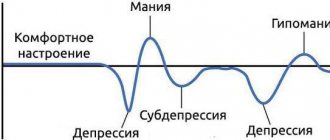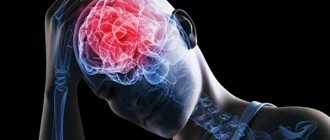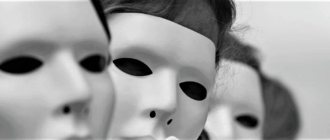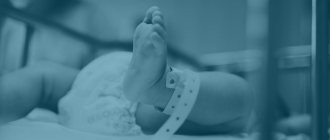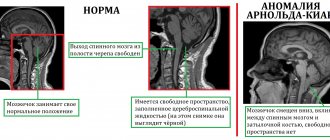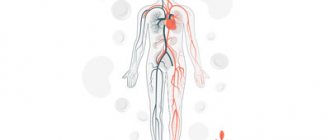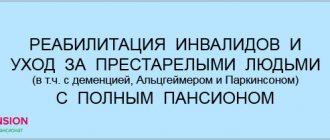Acalculia is a neuropsychiatric syndrome characterized by loss of the ability to perform arithmetic operations and perceive numbers. Develops when the dominant hemisphere is damaged: in right-handed people, the left hemisphere, in left-handed people, the right hemisphere.
Acalculia is an acquired disease and occurs against the background of damage to areas of the brain or neuropsychiatric diseases. It occurs against the background of disturbances in the temporal, parietal and occipital regions of the cerebral cortex, which in turn arises due to injuries, neuroinfections, neoplasms, etc.
Acalculia also often develops against the background of an underlying neurological or mental illness. Thus, acalculia is often combined with the following diseases: optical agnosia, alexia, dyslexia, acoustic-mnestic aphasia, attention deficit, sensory aphasia, amnesia, dementia, stroke.
Reasons for violation
Acalculia occurs due to damage to the parietal, occipital, temporal and prefrontal parts of the cerebral cortex. The causes of such brain damage can be different:
- a significant number of neurological disorders in the perinatal period
- hereditary factor;
- organic brain lesions;
- neuroinfections;
- neoplasms in the brain;
- various intoxications;
- dysmetabolic abnormalities;
- brain damage due to infectious diseases;
- negative social environment;
- cerebrovascular diseases;
- traumatic brain injuries.
Treatment
Acalculia is treatable, but to completely eliminate the symptoms, it is necessary to eliminate the cause of the pathology, the disease that caused the disorders. A different situation arises with dyscalculia. Since this disease is not acquired, but congenital, treatment involves only correction and preventive measures.
Treatment methods for acalculia will depend on the patient's age and the severity of the disease. If an adult is sick, therapy will be carried out with specialists using various computer programs. The patient is gradually brought to awareness of the concept of number. After this, learning mathematical operations begins, from simple to more complex.
For children, treatment is based on play. Most often, pictures with numbers are used for this. The child is visually taught to distinguish numbers.
Correction of dyscalculia should be carried out by a speech therapist. If necessary, a psychologist and a neurologist can be involved in working with the patient. Special techniques are being developed for correction. Classes can take place in any place comfortable for the child. The technique consists of a whole set of game exercises that teach counting. Also, classes should be aimed at developing the child’s speech, thinking, and visual abilities.
To eliminate dyscalculia, it is very important to develop competent and coherent speech. Correction should be based on expanding the child’s vocabulary while simultaneously learning mathematical terms
at the very beginning, an understanding of more, less, the name of geometric figures, and the characteristics of an object should be introduced.
The next stage introduces teaching ordinal counting and the use of numbers in speech. The child is taught to compare numbers, objects, their quantity, and quality characteristics. The child forms a connection between a number and its visual expression in writing. Both fine motor skills and thinking develop immediately.
As soon as stable achievements in counting are achieved, the teacher moves on to simple arithmetic operations. The goal is to show the child the logic of the solution.
Types and forms of the disease
The development of acalculia occurs with disorders of various cognitive systems. Depending on which cognitive function is affected, the following types of disease are distinguished:
- Verbal – deviations in the verbal designation of mathematical concepts. The patient can successfully perform mathematical operations, but cannot verbally indicate the names of numbers, symbols, and is unable to indicate the number of objects.
- Apraxic – a person is unable to count objects. The patient cannot count objects and identify their quantitative characteristics.
- Dyslexic – lack of ability to read mathematical symbols and express quantitative terms.
- Graphic – the inability to write down mathematical symbols and signs, as well as to correctly depict geometric figures.
- Operational – loss of ability to perform mathematical operations.
Also, cases of acalculia can be divided on the basis of primary and secondary.
Primary (specific) – caused by lesions of areas of the cerebral cortex, the following types are distinguished:
- Frontal - caused by dysfunction of the frontal lobe of the brain, which is responsible for the control and regulation of all human mental functions. The ability to count is impaired due to deviations in the organization of conscious activity.
- Parietal (parieto-occipital) - occurs when the parieto-occipital areas of the brain are damaged. The patient’s concept of “number”, understanding of the essence of counting operations, and perception of spatial coordinates are impaired.
Secondary (nonspecific) – occurs due to a neuropsychiatric disease, the following types are distinguished:
- Optical - occurs with pathologies of the lobes of the brain responsible for the visual analyzer. With optical acalculia, the visual perception of numbers and mathematical symbols is impaired. The patient is unable to distinguish between similar arithmetic symbols and recognize Roman numerals.
- Sensory – develops with damage to areas of the brain involved in the acoustic perception of speech. Manifests itself in difficulties with oral counting and carrying out counting operations by ear.
- Acoustic-mnemonic – also associated with the acoustic perception of speech. The difference is that the patient has impaired auditory-verbal memory and a reduced volume of auditory perception.
Difference from dyscalculia
Acalculia and dyscalculia are similar concepts, but there are differences between them. It lies in the fact that dyscalculia is a consequence of congenital disorders of brain development and with it mathematical knowledge is not fully absorbed. Acalculia is an acquired condition, and occurs due to neurological injuries and disorders acquired during life.
Diagnosis and treatment
Due to the fact that numeracy disorder is often combined with other types of pathology of cognitive functions, acalculia syndrome may not be diagnosed at all (simply not noticed behind the leading cognitive deficit). However, its identification is necessary work, on the basis of which a system of therapeutic measures is developed. To confirm the presence of a violation of the skill of counting operations and assign it to a certain group, a number of neuropsychological tests are carried out to identify a counting disorder, pathology of speech, reading, writing, spatial orientation and praxis.
Treatment of acalculia, just like correction of dyscalculia, is a labor-intensive and lengthy process. This requires close contact between the doctor and the patient.
First of all, therapeutic measures are aimed at the cause of the development of the syndrome . Only by eliminating or correcting etiological factors can you fully work on restoring numeracy skills. If acalculia is secondary, work is carried out in parallel on other lost cognitive functions. In this case it is necessary to observe:
- the principle of comprehensiveness of treatment - a combined medical, psychological and pedagogical impact is assumed;
- systematic approach - activities are aimed not only at the isolated restoration of the skill of counting operations, but also at the root cause of the defect;
- staging, continuity and duration of work with the patient for a better treatment result;
- taking into account the psychological atmosphere during the process of restoring numeracy skills;
- taking into account the characteristics of other higher mental functions (gnosis, praxis, speech).
Currently, due to the ubiquity of the need for counting operations, the problem of forming mathematical concepts is quite acute. The situation is aggravated not only by the possibility of acquired loss of counting skills, but also by a defect in the ability to perform arithmetic operations with a delay in the formation of the counting center in the cortex. Acalculia and dyscalculia can manifest themselves in various combinations with other cognitive disorders and significantly reduce a person’s social adaptation. Timely and comprehensive correction of lost or undeveloped skills to perform arithmetic operations can significantly improve treatment results and improve the patient’s quality of life.
Symptoms of the disorder
Symptoms of acalculia vary depending on the form of the disease.
In the primary form of the disorder, the patient experiences the following symptoms:
- difficulty understanding the difference between seemingly similar numbers (for example, 147 and 174);
- inability to perceive the category of numerical digits;
- difficulties performing simple arithmetic operations;
- violation of understanding of the concept of “number”;
- lack of ability to compare numerical values;
- the perception of spatial coordinates is impaired;
- difficulties in estimating numbers containing the digit “zero”;
- Difficulty with subtraction, but addition is relatively easy.
The secondary form of acalculia is manifested by the following symptoms:
- there is no visual perception of numbers, and ignorance of their names;
- the perception of numbers and mathematical operations by ear is impaired;
- problems with understanding mathematical operations, planning them and controlling their execution.
Types of acalculia
The condition is classified by the reason it appears and what changes it causes.
So, acalculia can be primary or secondary. With the primary growth, the center responsible for the ability to count is directly affected, and with the secondary, pathological changes occur in various parts of the cerebral cortex, which to one degree or another are involved in the process of perceiving numbers and counting.
Depending on what violations are observed in this condition, four of its varieties are distinguished.
- Optical.
The patient has an exclusively visual impairment in the perception of numbers. This condition is typical when the occipital region of the cerebral cortex is affected. Usually the phenomenon is combined with visual agosia. - Sensory or auditory.
The condition is characterized by the fact that there is a violation in the recognition of speech and sounds. Difficulties usually arise not only with mathematics, but also with general understanding. This pathological condition develops when the superior temporal gyrus is damaged. It is combined with sensory aphasia. - Amnestic.
This type is characterized by impaired auditory-verbal memory. It occurs when the underlying pathology affects the temporal cortex of the cerebral hemispheres. There are also other memory impairments. - Frontal.
Any arithmetic operations are impossible due to a disorder in the organization of purposeful activities. Other manifestations of the underlying disease of apraxia are also noted.
After identifying the cause of the disorder, treatment is prescribed to eliminate the underlying pathology.
Inspection and diagnostics
A defectologist, psychologist, psychiatrist, or specialist in neuropsychology can identify the disease.
Numeracy disorder is rarely the only cognitive disorder and is often accompanied by other pathologies. Acalculia may not be detected during the initial examination and diagnosis due to more intense manifestations of other disorders.
The diagnosis can be made after performing arithmetic tests and analyzing them. Excessively low results indicate pathology. It is also necessary to use such diagnostic measures as tests to identify pathologies of speech, writing, reading, spatial orientation, and praxis.
The main thing about acalculia
The condition is a symptom, not the disease itself.
It can occur at any age and requires comprehensive treatment. The older the patient, the lower the likelihood of a favorable prognosis. Acalculia manifests itself in various counting disorders depending on which areas of the brain are affected. Correction is also prescribed based on what caused the disorder and what part of the brain is affected.
Have you encountered acalculia in your loved ones? Write in the comments how your treatment is going.
Elizarova Lilia · Mar 12, 2019
Treatment and correction
When treating acalculia, the main therapeutic measures should be aimed at eliminating the causes of the disease.
The choice of correction program depends on the form of the disease and, accordingly, the causes of its occurrence. Complex therapy is carried out by the following specialists: clinical psychologist, defectologist, psychiatrist, neuropsychology specialist.
Primary violation
In the primary form of acalculia, the main task is to restore the patient’s perception of numbers and their digits. Special techniques are used, the main principle of which is to work with the patient’s visual memory.
Cards with images of numbers, objects and their quantities are used. It is preferable to use bright and varied colors, as this promotes better perception and memory. When working with children, it is advisable to use play forms.
Working with numbers involves the need to decompose any of them into variations. An auxiliary tool can be sticks. For example, the patient is given the number 7 and given the task of breaking it down into its possible components.
The patient performs this task by arranging the sticks in the following combinations: 3+4, 2+5, 1+6. All actions are recorded in a therapy diary. As the result progresses, oral commentary on mathematical operations is added - all operations are accompanied by pronunciation. This helps develop the ability to count mentally.
If the perception of the names of numbers and their digits is impaired, the work of specialists is to pronounce numbers from 1 to 100 together with the patient, and provide parallel explanations regarding units and tens. One of the exercises is to write numbers in numbers under their letter symbols. For example, next to the words two hundred and forty one write 241.
After 3 lessons, oral forms of work and voicing of arithmetic operations should be added to visual and figurative materials.
Therapy for the secondary form
Treatment for the secondary form of acalculia is selected depending on the area of damage to the cerebral cortex:
- When the occipital cortex is damaged, treatment is aimed at restoring the correct spelling of numbers and their visual perception. The following methods are aimed at this: exercises with a motor image of a number, object counting, various manipulations with tasks and numbers, voicing numbers while simultaneously imagining them in the mind. The best results are achieved with a satisfactory level of development of visual memory, imagination, and auditory perception.
- When the temporal areas of the cerebral cortex are damaged, patients have impaired auditory perception of numbers. For this disorder, there is no need for specialized therapy.
- For disorders in the prefrontal cortex, therapeutic measures are aimed at teaching the understanding of numbers and simple arithmetic operations, gradually moving on to more complex operations.
Clinical and psychological characteristics of acalculia and dyscalculia in childhood
Tatyana Lakhtina
Clinical and psychological characteristics of acalculia and dyscalculia in childhood
«Clinical and psychological characteristics of acalculia and dyscalculia in childhood»
Content
Introduction page 3
1. Clinical and psychological characteristics of acalculia p.. 5
2. Clinical and psychological characteristics of dyscalculia p.. 8
Conclusion page 11
References page 13
Introduction
Until now, not only in our country, but also in foreign countries, books on counting disorders, and especially on methods for overcoming it, are numbered in units. The paucity of research into acalculia and the development of methods to overcome it is due to a number of reasons. One of them is the fact that acalculia is included in the syndrome of almost all forms of aphasia, in which speech impairment often masks defects in counting and counting operations. Therefore, the priority task has always been to restore speech, which (historically)
Speech therapists were involved.
Psychologists and neuropsychologists became involved in this work and in scientific research in this area much later. In the absence of sufficient time to work with patients in the clinic , it is natural that, first of all, patients were taught to speak and understand speech, write and read, and there was no time left for classes to overcome difficulties in counting. Therefore, the research and methodological aspects of acalculia have not received proper development.
Another reason can be considered the difficulty of the subject of study itself - the psychology of counting and counting operations, the concept of the bit structure of numbers, types and causes of their violation, the connection of counting with thinking, speech, cognitive processes, etc. As a consequence of these difficulties, obstacles arose to the development of methods for overcoming this the most complex type of intellectual activity. Acalculia is a violation of the ability to perform arithmetic operations caused by damage to the cortex of the left hemisphere of the brain. Rarely seen in isolation, often combined with aphasia
Dyscalculia is a specific disorder of learning to count, manifesting itself at different ages in the preschool and school populations.
Dyscalculia is caused by a number of mechanisms that combine the immaturity of higher mental functions involved in the process of mastering numeracy skills (attention, memory, abstract logical thinking, visual-spatial and visual-perceptual gnosis, emotional-volitional reactions.
The objectives of this work include:
1) consideration of the clinical and psychological characteristics of acalculia ;
2) study of the clinical and psychological characteristics of dyscalculia .
1. Clinical and psychological characteristics of acalculia
Acalculia is a violation of the ability to perform arithmetic operations caused by damage to the cortex of the left hemisphere of the brain. Rarely seen in isolation, more often combined with aphasia 1
Acalculia (from Greek a negative particle and Latin calculatio account, calculation)
neuropsychological symptom described by SE Henschen in 1919.
Characterized by violation of counting operations.
Primary acalculia, as a symptom independent of other disorders of higher mental functions, is observed with damage to the parieto-occipitotemporal cortex of the left hemisphere and represents a violation of the understanding of spatial relationships, lack of understanding of the transition through ten associated with the bit structure of a number, failure to distinguish arithmetic signs, etc.
Secondary acalculia , which is part of the structure of a particular neuropsychological syndrome, can occur with damage to the temporal parts of the cerebral cortex, when oral counting is impaired, the occipital areas, when numbers similar in writing are not distinguished, and the prefrontal areas, when purposeful activity and planning of counting operations are impaired and monitoring their implementation.
Primary acalculia . A rare form of acalculia , in which counting disorders are found on their own, regardless of other disorders of higher cortical functions. Secondary acalculia is spoken of in cases where counting disorders are part of the structure of a neuropsychological syndrome in combination with memory impairment, aphasic symptoms, and pronounced perseverations.
The most common is primary acalculia , which occurs when the parietal parts of the brain are damaged. This form is the main one - here arithmetic operations are violated from their essential side. Patients lose their understanding of spatial reference schemes, their concept of number and the concept of digit capacity of its recording are disrupted. Often these patients do not understand the meaning of arithmetic signs and cannot carry out the actions indicated by them.
The training of patients in this group is aimed primarily at restoring spatial reference schemes, at restoring the concept of number (its composition and digit capacity, understanding the composition of arithmetic operations, etc. At a certain stage of training, a significant role belongs to loud speech - pronunciation.
Arithmetic operations may also be impaired if the frontal systems of the brain are damaged. In this case, their violations take on a different picture. They do not affect the essential side of actions, but concern them only secondary and are the result of the collapse of general forms of intellectual activity.
There are violations of arithmetic operations occurring in the syndrome of inactivity, increased inertia of stereotypes, motor and speech perseverations (damage to the posterior frontal parts of the brain, then in the syndrome of general disinhibition of behavior, decreased concentration of attention, impulsivity (damage to the basal parts of the frontal systems of the brain, then in the syndrome of pathology of approximately research activity, behavioral strategy, impaired selectivity of connections (damage to the polar parts of the frontal region of the brain)
.
In all these cases, the picture of violations is different and correction of defects requires a different approach. But all these varieties of acalculia have no fundamental differences - they are all of secondary origin and do not affect the essential side of the actions.
Methods for overcoming these defects, differing from each other in minor ways, should be aimed primarily at restoring the patient’s general behavior in the situation of performing arithmetic operations, the patient’s focus, and creating conditions that allow him to realize the need to control his actions.
Secondary disturbances of action often occur with damage to the occipital parts of the cerebral cortex and occur in the syndrome of visual perception disorders. Remedial training, aimed at overcoming defects in the perception of numbers and their combinations, leads to the restoration of counting. Psychological analysis of this process allows us to once again verify the complex structure of intellectual activity, which includes in its structure, in addition to specific operations, a general strategy that subordinates operational components. Both of these sides of the intellectual act and their interdependence are important and necessary. Violation of one of them inevitably leads to disruption of all activities as a whole.
2. Clinical and psychological characteristics of dyscalculia
Dyscalculia is a specific disorder of learning to count, manifesting itself at different ages in the preschool and school populations.
Symptoms of specific dyscalculia are expressed in difficulties:
understanding the bit structure of number and the concept of number;
understanding the internal composition of numbers and the connections between numbers;
understanding the left and right components of a number, the meaning of zero;
listing and building automated digital, especially
ordinal, rows;
performing basic computational operations (addition, especially with passing through ten, subtraction, division, multiplication);
recognition of numeric characters;
correlation of numbers in arithmetic operations;
memorizing multiplication tables;
solving problems that require understanding the meaning and several logical operations with retention of certain actions in memory;
visual-spatial perception of the connection between numbers and the verbalization of the counting process;
revealing the mathematical content of diagrams and pictures leading to the correct answer;
performing complex logical-abstract operations included in algebra, geometry, trigonometry, physics, etc.
Dyscalculia is caused by a number of mechanisms that combine the immaturity of higher mental functions involved in the process of mastering numeracy skills (attention, memory, abstract-logical thinking, visual-spatial and visual-perceptual gnosis, emotional-volitional reactions. Unstable behavior of children against the background of social disadvantage is often noted and pedagogical neglect. The following should be excluded: counting disorders caused by mental retardation, inadequate training, emotional disturbances, visual and hearing disorders, social deprivation. The severity of dyscalculia can be expressed from mild and moderate to high, depending on the age-related formation of higher mental functions. Clinical Diagnosis of specific dyscalculia is complicated by the multiple meanings of the etiology of the disease.The child’s productivity in mastering arithmetic is significantly lower than the age level expected in accordance with the level of intellectual development and academic performance indicators. Assessment is based on standardized numeracy tests. Reading and spelling skills should be within the normal range for mental age . Some children have associated social-emotional-behavioral problems.
Treatment of dyscalculia . Complex medical and pedagogical activities are carried out in outpatient clinics , children's institutions and a school speech therapy center. It is expected that specialists from different fields will work together: a speech therapist, a psychologist, a neurologist, etc. The complex of diagnostic measures must include a speech therapy examination using neuropsychological testing at the beginning and at the end of the course of treatment. This includes studies of impressive speech, expressive speech, gnosis, praxis, functions of reading, writing, counting, memory, constructive-spatial activity, intelligence (according to Wechsler’s children’s method )
etc. Of decisive importance in the correction of
dyscalculia in this group of children is the implementation of a special set of pedagogical, including speech therapy, and drug therapy aimed at eliminating certain disorders of higher functions and visual-spatial gnosis. It is important to carry out an adequate course of treatment aimed at activating the activity of brain structures. Conducting a course of speech therapy classes is recommended in an individual form with a transition to a group one. Depending on the severity of dyscalculia and the forms of its manifestation, classes are aimed at developing the concept of number composition, counting skills, logical-abstract and visual-spatial mental activity, developing the ability to program arithmetic (mathematical)
structures, and developing self-control processes.
Conclusion
At the heart of the violation of arithmetic skills ( acalculia , dyscalculia )
There is cortical right hemisphere insufficiency, mainly in the posterior parietal and occipital areas responsible for the processing of visual-spatial information and for the development of mathematical skills.
Violations are detected with the beginning of schooling, when, despite satisfactory progress in other subjects, patients noticeably lag behind their peers even in adding single-digit numbers. For some time, the disorder may not be too noticeable if the child relies on his perseverance and ability to learn material by heart, but it becomes completely obvious when the program becomes more complex and the demands on spatial thinking increase. Skills that require abstract mathematical thinking are also challenging, but to a lesser extent than basic arithmetic. There may be a connection with impaired attention, speech pathology, other disorders of school skills, as well as secondary emotional and behavioral problems, which patients pay attention to first. Lack of success in correcting the disorder may be complicated by decreased motivation to study and self-esteem, as well as depressive symptoms. Social adjustment in adulthood depends on the preservation of self-esteem, motivation for social success, and skills in using a calculator.
The disorder can manifest itself in any combination of impairments in a number of skills, including linguistic (using mathematical terms, organizing verbal content in the form of mathematical symbols), perceptual (recognizing numbers or mathematical symbols, grouping objects, concentration (concentration when copying numbers, observing operational symbols) and actual mathematical (counting, using multiplication tables, finding a sequence of operations).
Rehabilitation measures for numeracy disorder are complex . Complex medical and pedagogical activities are carried out in outpatient clinics , children's institutions and a school speech therapy center. It is expected that specialists from different fields will work together: a speech therapist, a psychologist, a neurologist, etc. The complex of diagnostic measures must include a speech therapy examination using neuropsychological testing at the beginning and at the end of the course of treatment.
Methods for overcoming these defects, differing from each other in minor ways, should be aimed primarily at restoring the patient’s general behavior in the situation of performing arithmetic operations, the patient’s focus, and creating conditions that allow him to realize the need to control his actions.
Bibliography
1. Vid V.D., Popov Yu.V. Clinical psychiatry . – St. Petersburg: Medicine, 2000. – 426 p.
2. Speech therapy / Ed. N. G. Solnechnaya. – M.: Pedagogy, 2000. – 362 p.
3. Medical Dictionary / Ed. A. L. Kushnareva. – M.: Medinfo, 2004. – 683 p.
4. Psychological Dictionary / Ed. N. I. Nikulicheva. – St. Petersburg: Print, 2003. – 724 p.
5. Tsvetkova L. S. Impairment and restoration of counting in local brain lesions - M.: Publishing house of the Moscow Psychological and Social Institute, 2003. - 112 p.
Implications and Limitations
Acalculia can cause various complications.
Such negative consequences include agrammatism (difficulties in composing and perceiving sentences), paraphasia (replacement of sounds, incorrect use of sounds), speech embolus (obsessive repetition of a word or phrase). The consequences of acalculia also include a decrease in an individual’s social adaptation due to a combination of the disease with other cognitive impairments. As a result, the patient's quality of life decreases.
When the disease develops in children, this causes problems in learning, social adaptation at school, impairs communication skills and can negatively affect the child’s further cognitive development. Children may develop low self-esteem and depression.
Diagnostics
This type of disorder is fairly easy to diagnose.
For the first time, attention was paid to the disease at school. Such a child can easily count to ten, but does not operate with larger numbers.
He is not able to understand the structure of numbers, to correlate the number and its spelling using numbers. Therefore, a child often has difficulty learning to tell time, practically does not remember dates, phone numbers, formulas, and at school cannot keep up with drawing, physics, and chemistry. If these symptoms appear, do not delay solving the problem.
Dyscalculia is a condition that must be corrected immediately. Sometimes the disease can be identified already in preschool age, when the child is just beginning to develop arithmetic abilities. Standard laboratory tests are not performed. In some cases, a CT or MRI of the brain may be needed.
Correction of dyscalculia
Most often, a speech therapist deals with the correction of dyscalculia. Also, if necessary, psychologists, pediatricians, and neurologists are involved. Classes can be held in specialized clinics, kindergartens, specialized groups or classes. For correctional classes, special game exercises are developed that teach counting, while simultaneously developing the child’s speech and thinking, his musical, visual, and learning abilities.
The development of coherent, full-fledged speech is an extremely important area of work for dyscalculia. Correction is carried out by expanding the vocabulary of children in parallel with teaching mathematical terms, their meanings and correct use
At the first stage, the concepts of less-more, equally, names of geometric shapes, generalizing the characteristics of objects are introduced. Next comes training in ordinal counting and the use of numbers in speech, comparison of objects and their quantities, a connection is formed between a number and its appearance in writing, the development of various types of memory, fine motor skills, and thinking.
When stable results in counting and comparison are achieved, the teacher moves on to teaching the simplest arithmetic operations, pronouncing and writing them, understanding the meaning of the problem, and the logic of the solution. Children's vocabulary and speech are expanding, and new ways of comparing objects are being taught. The concept of component parts, breaking an object into parts and putting it together from parts is introduced. Children learn to draw numbers and signs on paper. The development of motor skills, drawing skills, memory and speech continues.
Starting regular classes with a specialist in a timely manner will help eliminate the manifestations of dyscalculia in a child and increase his academic performance.
Therapy
All therapeutic measures are aimed, first of all, at treating the underlying pathology, which was the impetus for the development of this disease. So, treatment consists of several stages:
- correction of cerebral hemodynamics;
- neurometabolic therapy;
- measures aimed at preventing the development of cerebral edema;
- taking psychotropic drugs.
The goal of all subsequent measures is to eliminate the emerging neurological disorders, including the ability to perform arithmetic operations. This includes:
- Conducting arithmetic classes. There are various techniques aimed at correcting one or another type of acalculia, which have been successfully used for decades. With systematic exercise, most patients experience positive dynamics.
- Psychotherapeutic sessions. They are carried out with the aim of changing the patient’s attitude towards emerging problems, as well as in order to positively set the patient up for further treatment. Due to the fact that the course of treatment is quite long, and sometimes several courses are required, many patients experience depressive states, which in no case should be allowed.
- Classes with a speech therapist. They are not indicated for all patients, but only for those who have been diagnosed with an auditory form of acalculia.
If the disease occurs as a result of a stroke or injury, first of all, all necessary treatment measures are carried out in a hospital setting. Only after a patient in serious condition has been provided with all the necessary medical care and after he is on the mend can rehabilitation measures begin.
Sometimes acalculia occurs in conjunction with one of the chronic diseases, in which case patients are advised to undergo drug therapy along with rehabilitation.
Classification
It is customary to distinguish two types of acalculia according to the mechanism of occurrence: primary and secondary. Primary appears as a result of the appearance of certain violations in the area responsible for the score.
The secondary form of pathology appears due to damage to other areas involved in arithmetic operations. This type is divided into 4 subspecies:
- optical – people have impairments in number recognition;
- auditory – there are problems with the sound perception of numbers;
- amnestic – disorders affect auditory-verbal memory;
- frontal - a person cannot perform any arithmetic operations.
Development of the disease in children
At school age, about 5 percent of children suffer from dyscalculia. This is a misunderstanding of the principle of counting, the inability to distinguish between arithmetic operations. Acalculia and dyscalculia are interrelated diseases.
We are talking about acalculia if the child was mentally developed, but lost his ability as a result of injury or disease. With dyscalculia, the child loses the ability to learn any arithmetic operation, and often this is combined with the problem of the inability to recognize letters.
Dyscalculia in children begins to develop from an early age. It is expressed in the fact that it is simply impossible to teach such a child any arithmetic operations. His brain completely refuses to perceive this information. Most often, this disease occurs in children with a genetic predisposition. As a result, the disease develops into mental retardation.
Causes of dyscalculia
Dyscalculia can be either a consequence of general mental retardation or the result of exposure to various psychotraumatic factors.
Dyscalculia often occurs in children who have had a negative experience in learning to count - they were forced to learn, punished for poor results, the teacher could not find an approach to this child. All this leads to lack of confidence in one’s abilities, isolation, fear, and, as a result, to poor counting.
Possible organic causes of dyscalculia are difficulties in processing visual information, as a result of which the child cannot recognize the conditions of the task and the inability to remember mathematical formulas and patterns according to which problems are solved.
Dyscalculia often occurs in children from asocial families. In such children, all mechanisms for the formation of dyscalculia are involved.
